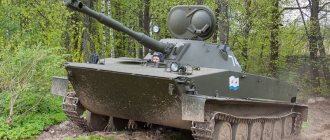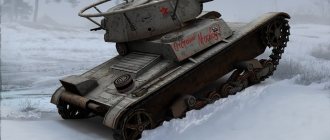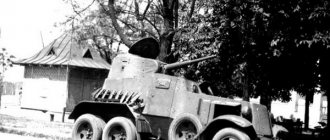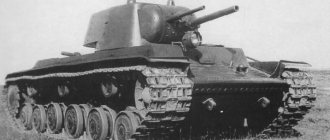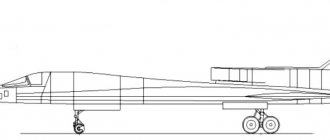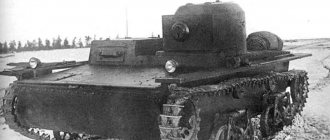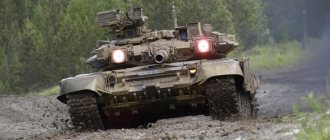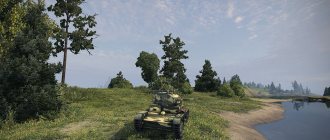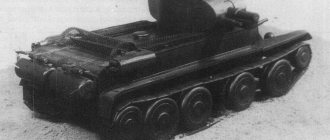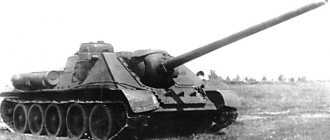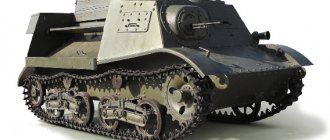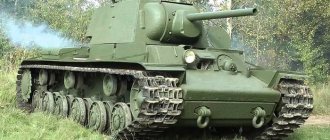History of creation
Based on the results of operating the T-27 wedges, it was found that the weapon would be more effective in a circular rotation turret. Also, for reconnaissance missions, it is desirable that the vehicle be able to cross impressive water obstacles, that is, be floating.
In 1931, a small amphibious tank was successfully tested in Great Britain. This vehicle was of interest to the Soviet authorities - in the future, it could well replace the T-27 wedge, which did not show such high combat effectiveness as we would like.
As a result, based on speculation about a British amphibious tank, the T-33 prototype was built in 1932. It showed sufficient buoyancy, but due to the complexity of production it never made it into series.
Some time after the release of the T-33, the T-41 amphibious tank was developed and built at the 2nd plant of the All-Union Automotive and Tractor Association. It was partially based on the T-27 wedge, produced at the same plant, and the chassis was taken from the T-33.
As a result, the T-33 was improved, becoming the T-37. But neither it nor the T-41 entered production due to numerous shortcomings.
In 1932, the USSR purchased British amphibians, which were abandoned in the creator country. Using information about the English tank, as well as the experience of the T-41 and T-37, Soviet designers eventually created the T-37A.
Unfortunately, by the time of its creation, the T-37A was no longer considered promising. During operation, shortcomings and shortcomings continued to be identified, and they decided to eliminate them by creating a new machine - the T-38, which soon almost completely replaced the T-37A.
Links[edit]
- Baryatinsky, B. (2003). Amphibians of the Red Army
. Moscow: Modeler-constructor. - Svirin, N. (2005). History of the Soviet tank 1917-1937 (History of the Soviet tank 1917-1937
). Moscow: Yauza. ISBN 5-699-13809-9. - Kholyavsky, G. (1998). Encyclopedia of Tank
. Minsk: Havrest. ISBN 985-13-8603-0. - Kolomiets M.V. (2003). Amphibious tanks T-37, T-38 and T-40 (Amphibious tanks T-37, T-38, T-40
). Moscow: KM Strategy. ISBN 5-901266-01-3.
Tactical and technical characteristics of the tank (TTX)
general information
- Classification – small/floating tank;
- Combat weight - 3.2 tons;
- The layout is classic;
- Crew – 2 people;
- Quantity produced: 2552 pieces.
Dimensions
- Case length – 3730 mm;
- Case width – 1940 mm;
- Height - 1840 mm.
Booking
- Armor type - rolled homogeneous steel;
- Body forehead – 8 mm;
- Bottom – 4 mm;
- Housing roof – 4 mm;
- Front, side and rear of the turret – 8 mm;
- Gun mantlet – 8 mm;
- Tower roof – 4 mm.
Armament
- Machine gun - 7.62 mm DT.
Mobility
- Engine type - in-line 4-cylinder carburetor;
- Engine power – 40 hp;
- Highway speed – 40 km/h;
- Speed over rough terrain – 6 km/h;
- Cruising range on the highway – 230 km;
- Suspension type: interlocked in pairs, on horizontal springs;
- Specific ground pressure - 0.55 kg/cm²;
- Climbability – 35 degrees;
- The wall to be overcome is 0.5 m;
- The ditch to be overcome is 1.4 m.
Modifications
- BKhM-4, chemical tank. Could be used for flame throwing or setting smoke screens;
- T-37RT, a vehicle with a radio station;
- T-37A, diesel, experimental model, which was not put into production due to the fact that the engines had to be purchased abroad;
- Su-37 is a self-propelled gun based on the T-37A, which was never accepted into mass production due to the small ammunition load and the overload of the commander.
Use in combat
In 1934, the first T-37A began to enter service with the troops to replace the T-27 tankettes. Many shortcomings were immediately identified - unreliability, poor maneuverability and low speed. As a result, in 1939 they were completely removed from the tank brigades, leaving them only in the reconnaissance companies of the rifle brigades. Gradually they remained only in reconnaissance units.
The T-37A received its baptism of fire in 1939, in battles against Japanese troops at Khalkhin Gol. The terrain in this area was deserted, and the amphibious properties of the vehicles were not needed, so the T-37A was mainly used to support infantry. As a result, they were recognized as unsuitable for either attack or defense, and due to poor reliability and security, 17 out of 25 vehicles were lost. Also, the T-37A was not used very successfully in 1939 during the Polish campaign.
The T-37A was used most actively during the Soviet-Finnish War. They were mainly used for security, as well as for reconnaissance and infantry support. There were cases when vehicles actually successfully crossed water obstacles. The T-37A also covered seams in battle formations well, but only if the enemy did not have anti-tank weapons.
In June 1941, the Red Army had about 2,300 T-37As of various types. Of these, 36% needed serious repairs, and 40-60% required military repairs. In the very first weeks of the war, a lot of vehicles were lost, and later they were used as ordinary ground vehicles. As a result, by 1942 there were very few T-37As left in the army, and they were used sporadically. However, there are two known cases when the T-37A was used for its intended purpose, that is, as amphibious tanks.
In August 1942, when it was necessary to form the Neva, a separate battalion was created, which included 29 T-37A and T-38 units. All the vehicles were worn out, but in the end the amphibious tanks managed to take a bridgehead on the enemy shore. True, the operation was unsuccessful, and the bridgehead had to be evacuated. 23 amphibious tanks were lost, and the remaining 6 were out of action for technical reasons even before the crossing.
In 1944, tanks were used to seize a bridgehead on the Svir River. This operation was more successful due to good preparation and led to the defeat of the enemy.
Until the end of the war, the T-37A was used in training units, but almost immediately after its end, all the vehicles were sent to scrap metal.
Use in other countries
- In 1934, one T-37A was sold to Turkey along with a batch of T-26s. After the tests, the Turkish military decided not to purchase a batch of tanks of this model;
- For quite a long time, 29 T-37A captured in the Winter War were operated by the Finnish army. One of them was transferred to Sweden, where it is still located. All captured tanks were written off by 1943;
- Several captured T-37As were periodically used by the German, Romanian and Hungarian armies.
Tank photos
Memory of a tank
Today three T-27As remain:
- At the Armored Museum in Kubinka. The car was not completely restored, without floats, but is in good condition;
- In a private collection near Yekaterinburg;
- In Sweden, at the Arsenal Museum of Military Equipment. This vehicle was captured during the Winter War.
More material on the topic
- M4 Sherman
- New deadly tank T90MS
Armor protection
The armor of the T-37A tank was developed according to the bulletproof principle. Its armor should be classified as light bulletproof and equal strength. It protected the tank and its crew only from main rifle calibers, and was completely powerless against larger caliber ammunition and large fragments hitting the tank.
The armored hull of a small amphibious tank had a fairly simple box-shaped shape, which was assembled from sheets of steel by riveting and welding them onto a common hull frame and among themselves using shim corners. To assemble the armored hull, solid rolled sheets of armor steel 4 millimeters thick were used for the bottom and roof, as well as 8 and 6 millimeters thick to form the frontal part of the hull, stern and sides, respectively.
Beginning in March 1934, the frontal part of the hull and the frontal elevation of the driver's cabin began to be formed from an armor plate 10 millimeters thick, which strengthened the anti-fragmentation protection of the tank and its crew. The sides of the hull had no angles of inclination to the vertical, and the front and rear parts, as well as the forehead of the towering driver's cabin, were inclined slightly.
Frontal part of the T-37A tank hull
The tank's turret was also assembled using welding and riveted connections from armor plates, attaching them to the frame and to each other. The thickness of the armor plate that formed the roof of the tower reached 4 millimeters. Its forehead, stern and sides were formed from a single armor plate, curved in the form of a cylinder, the thickness of which did not exceed 8 millimeters. The turret had a niche in the frontal part and was shifted to the right side relative to the longitudinal axis of the hull. Its installation was carried out on the ball support of the roof of the turret box. The turret was rotated manually using handles and a dividing mechanism. In the front part of the turret there was a hole for installing a mantlet (armor thickness 8 millimeters) of a machine gun.
Floating tank tower
Turret of the T-37A tank (side view) Patriot Park, Kubinka
Chassis, engine and transmission, electrical equipment
The engine of the T-37A amphibious tank was an in-line four-stroke four-cylinder liquid-cooled GAZ-AA carburetor engine, which could develop a maximum power of up to 40 horsepower. The fuel used was second-octane gasoline, which was poured into a tank located in the rear of the hull. This engine made it possible to reach speeds of up to 40 kilometers per hour when driving on the highway and up to 6 kilometers per hour afloat.
Carburetor engine GAZ-AA
The tank was equipped with a mechanical transmission, which included the following components and mechanisms:
• main single-disc clutch operating on the principle of dry friction; • four-speed manual transmission (with four forward speeds and one reverse); • stepped cardan shaft; • bevel type main gear; • brakes of block-type turning mechanisms, located outside the armored hull of the tank; • differential rotation mechanism.
The chassis included four single rubber-coated road wheels, three rubber-coated support rollers, a rubber-coated sloth and a single sprocket-shaped drive wheel. The support rollers were suspended interlocked in pairs in a “scissors” pattern. In this case, each support roller was mounted on one end of a triangular-shaped balancer, and the other end of the balancer was attached to a hinge directly to the tank body, the third end of the balancer was mated in pairs by a spring with the next balancer of the trolley.
Chassis with four single rubber-coated road wheels
The type of caterpillar of the T-37A tank was double-ridged with a lantern engagement and an open hinge. Each of the two tank tracks was assembled from 86 cast steel tracks with developed lugs, having a width of 200 millimeters and a pitch of 87 millimeters. The tracks were made using ductile iron casting.
Exhaust pipe at the rear of the tank
The electrical equipment is made according to a single-wire circuit, the on-board voltage is 6 V. The ignition system is battery-based. The engine was started from the control compartment using an electric starter or a special starting lever
Tests of the TVD-2 suspension of the Research Institute of the Red Army Air Force on the TB-3 aircraft. Tank T-37A, Bear Lakes, October 1936
Dropping a T-37A tank into the water from a BT-3 aircraft. Bear Lakes, 1936
T-37A forces the water barrier during the Great Kyiv Maneuvers
T-37A tanks are preparing for the parade marking the end of the Great Kyiv Maneuvers, September 1935.
Soviet light tank T-37A
T-37A during maneuvers in Belarus 1935
Armament
The main and only armament of this vehicle was a 7.62 mm DT tank machine gun, developed in 1929. It was installed in a ball-mounted mantlet in the frontal part of the turret. The swing of the ball made it possible to aim the machine gun with the turret in a stationary position within 30 degrees in the horizontal plane and in the range from −20 to +30° in the vertical plane. The machine gun's ammunition included 2,142 rounds of ammunition, which were placed in 34 three-row disk magazines of 63 rounds each. The stores were placed in stowages on the left side of the hull and the sides of the turret.
